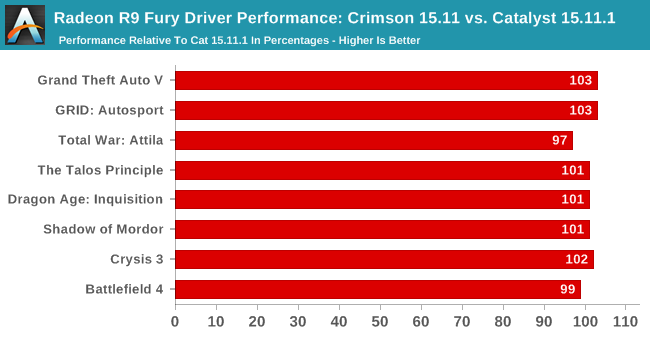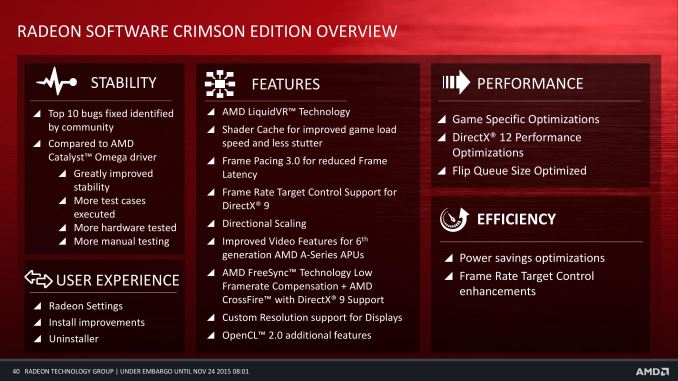AMD's Radeon Software Crimson Driver Released: New Features & A New Look
by Ryan Smith & Daniel Williams on November 24, 2015 8:00 AM ESTCrimson Performance
Last but certainly not least, let’s talk about performance improvements. Like the Omega driver before it, Crimson comes with a collection of performance improvements from AMD’s new driver branch. To preface this with caution, I don’t think anyone should be expecting massive system-wide performance gains – that’s all low-hanging fruit AMD picked long ago – but there’s plenty of room for some lesser optimizations along with game-specific optimizations.
AMD’s own numbers point to game-specific improvements of up to 20%, though it should be noted that AMD’s best-case numbers are on unreleased/beta games that have yet to be well-optimized in the first place. Otherwise AMD’s own numbers are far more tame, listing recently released games with gains between three and five percent.
To take a quick look at general performance, we went ahead and ran our GPU benchmark suite at 2560x1440 on our Radeon R9 Fury (vanilla), comparing the previous Catalyst 15.11.1 beta to the new Radeon Software Crimson 15.11 beta. The Fury and its underlying Fiji GPU is the newest product out of AMD, so it offers AMD the best opportunity to unlock any remaining performance in the architecture.

Overall the average performance gain at 2560x1440 is just 1%. There are a couple of instances where there are small-but-consistent performance gains – Grand Theft Auto V and Grid: Autosport stand out here – but otherwise the performance in our other games is within the margin of error, plus or minus. Not that we were expecting anything different as this never was pitched as a golden driver, but this does make it clear that more significant performance gains are going be on a per-game basis.
Final Thoughts
Wrapping things up, AMD’s development structure in the past year and going forward is one that has both been beneficial to the company and has brought with it its own drawbacks. By focusing feature releases around the end of the year driver, AMD is able to cut down on what parts of the driver they change (and thereby can possibly break) at other times of the year, and try to knock out all of their feature-related bugs at once. At the same time it makes the annual driver release a significant event, as AMD releases a number of new features all at once. However on the other hand this means that AMD has few features launching any other time of the year, which can make it look like they’re not heavily invested in feature development at those points. Then of course there’s the WHQL element, where for multiple reasons AMD hasn’t issued very many WHQL releases this year, and is something they’re seeking to change in 2016.
Looking under the hood there’s no single feature that’s going to blow every Radeon user away at once, but overall there are a number of neat features here that should be welcomed by various user groups. The Freesync Low Framerate Compensation changes should be of particular interest to Freesync users, while shader caching will improve shader loading performance across the board. Otherwise smaller fixes like the DirectX 9 improvements to CrossFire frame pacing, CrossFire Freesync, and framerate target control should be welcome news to APU and dual graphics users.
Meanwhile AMD’s radical overhaul of their control panel via the new Radeon Settings application will be quickly noticed by everyone. Though there’s plenty of room for interpretation on style and just how a good control panel is laid out, AMD has clearly put a lot of effort into cleaning up the layout of their control panel and it shows, as important options are no longer buried under multiple layers of menu trees. And on the performance front Radeon Settings is faster than Catalyst Control Center even on fast machines, and though we haven’t spent much time on covering it, AMD has also managed to speed up the installation process while they were at it. So all-told the Crimson release has something for everyone.
Ultimately I hesitate to ascribe too much of this to the Radeon Technologies Group too soon – this project has clearly been in the works longer than 3 months – but at the same time this is the RTG making their mark. It’s a new direction for AMD’s graphics group and a new look to match. And if the RTG can meet their stability, performance, and release goals going forward with the new Crimson driver, then they should be able to make 2016 a good year for the Radeon user base.


















146 Comments
View All Comments
tuxfool - Tuesday, November 24, 2015 - link
If You never get that, then clearly it isn't happening to anybody else.Glenn37216 - Tuesday, November 24, 2015 - link
Me neither .. I have 970's , 980's , 980ti's ... hmm maybe he needs to quit going to pornhub so much !Alexvrb - Tuesday, November 24, 2015 - link
Nobody likes a quitter! Besides, it doesn't crash on an AMD GPU- I MEAN-- nevermind...looncraz - Tuesday, November 24, 2015 - link
I've had to fix issues like that on both sides when using multiple monitors.This new driver from AMD, though, is awesome! I can now set a simple low global clockspeed, then set speeds per game, without all of my previous profile work. And framerate control is fantastic, I set the default at 60fps, then set just a few games to go faster. My default clocks are -45%, -40% lower power, and 500MHz RAM (default is 1250). It goes back up to stock for BF4 and Hitman. Other than that, nothing I play requires the full power of an R9 290 (not even Crysis), and some games hit stupidly high framerates.
AS118 - Tuesday, November 24, 2015 - link
Yeah, that's true. I've used Nvidia and AMD drivers, and while both are actually pretty good, I noticed that Nvidia's faster drivers can be buggier, even if they're WHQL, whereas AMD's instabilities are usually found more in the betas. They may take longer to put out WHQL drivers, but I find that they're more stable because of it.That said, near about 90% of the time, I've had no trouble with Nvidia or AMD drivers, even the beta ones. I don't use Crossfire / SLI or the latest tech though. That generally leads to more issues, especially if you combine them (using 2 of the just released cards in Crossfire, etc.)
dkizzy - Tuesday, November 24, 2015 - link
Dude forget these haters. I still have that problem on my BenQ XL2420Z 144hz. I have to run it at 120hz to get the card to clcok down on the desktop.looncraz - Tuesday, November 24, 2015 - link
People don't seem to realize that even AMD's beta drivers would probably pass WHQL testing. Doesn't make much sense to have a main branch that isn't in an acceptable state. The beta drivers are just branches of the WHQL'd drivers with a few fixes applied.More WHQL drivers means absolutely nothing.
bolek - Thursday, December 17, 2015 - link
This. No drivers, beta or not, are released without running WHQL tests internally. The official WHQL certification matters for OEMs like Dell or HP, but has zero impact on gamers.Dalamar6 - Wednesday, November 25, 2015 - link
Both companies have their ups and downs, but there is no excuse for AMD's crippling rolling release linux distributions because they never update drivers. For months/years on end.Oxford Guy - Thursday, November 26, 2015 - link
Don't forget the magical "mouse does nothing for a while" syndrome that was also a virtue of at least one, if not more, of their driver releases.